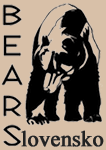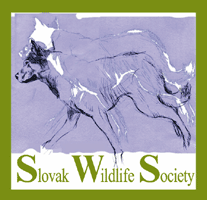

Bears and humans
The ancestors of bears lived on Earth before people. By 20 million years ago the first ancient bears appeared, about the size of dogs and with a long tail. Later, during the Ice Age 250,000 years ago, cave bears as well as the direct ancestors of brown bears gradually arrived in Europe from Asia. Cave-dwelling bears died out 10,000 years ago, but signs of them remain till this day - bones, teeth and claws. These have been found in caves in Slovakia, too, for example in Demänovská Valley. Prehistoric Man not only hunted bears for meat, but he also utilised their skin and bones – as weapons or tools. He drew animals on the walls of caves and we can see that he had respect for them. These signs were a kind of ceremonial ritual for a successful hunt.
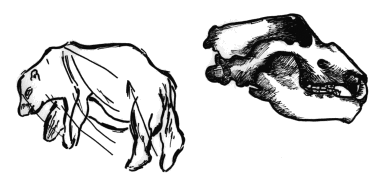
Many primitive tribes in Siberia and in North America showed great respect for the bear. Killing him with spears, arrows or a knife called for considerable skill and bravery. That he could stand on his hind legs, had tracks similar to human ones and had certain characteristics reminded them of a person. They regarded him as a protector. According to some tribes the bear was the ancient ancestor of the human race. They often accorded him a shaman’s healing powers. They carried claws or teeth in a protective amulet and as a mark of bravery in battle. They called him their brother and when they had to kill him they first danced a ceremonial dance to ask the spirit of the bear for forgiveness. Canadian Indians portrayed him in their totems as one of the sacred animals.
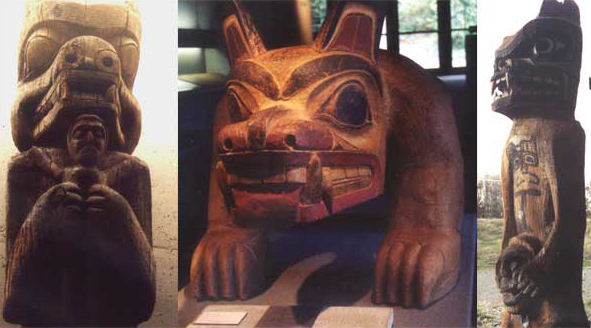
The symbol of the bear also often appeared in the ceremonies and customs of
the Slavs. At carnivals, masks were traditionally prepared and they dressed
in bear skins. There were legends and myths of children raised by she-bears
as well as many fairy tales.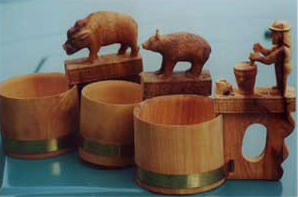 “Bear, give me your paw” is a well-known song and
folk dance. It comes from the time of nomadic gypsies and entertainers, who
brought "dancing bears". Folk artists portrayed the bear on functional
objects, such as on milk tankards as they could often meet him on the farm.
The bear appeared on the crests of the Orava and Spiš districts of the former
Hungarian Empire and today can still be seen on the crests of several villages
in Slovakia.
“Bear, give me your paw” is a well-known song and
folk dance. It comes from the time of nomadic gypsies and entertainers, who
brought "dancing bears". Folk artists portrayed the bear on functional
objects, such as on milk tankards as they could often meet him on the farm.
The bear appeared on the crests of the Orava and Spiš districts of the former
Hungarian Empire and today can still be seen on the crests of several villages
in Slovakia.
In the past bears had plenty of space to live in, but humans gradually cut down forests, changed them into fields and pastures and settled the land. In this way bears and people came into conflict more often. Bears attacked livestock and visited beehives or fields with crops. They were no longer hunted only by the nobility for sport, but were also persecuted by peasants as vermin. Various methods were used for killing: catching in pits, enclosures, traps and at baits. In the 18th century a reward of seven gold pieces was paid for killing a bear. People used the bear’s meat (the paws were a delicacy) and skin; the gall bladder was highly valued in folk medicine. The number of bears fell steeply and before the Second World War there were only a few tens of them left in Slovakia.
In 1932 people realised that the bear was gravely endangered. Year-round protection
was declared by law. 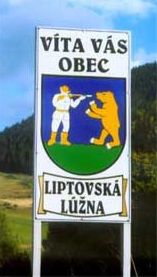 Gradually bears spread back, at least into parts of their
former home – the forests of northern and central Slovakia, where they still
exist today.
Gradually bears spread back, at least into parts of their
former home – the forests of northern and central Slovakia, where they still
exist today.
Because bears live secretive lives in large areas that are not easily accessible,
it is difficult to determine their exact number. Experts estimate that 600-800
individuals live in Slovakia at present. The bear is protected all year round,
but the ministry issues several tens of exceptions for shooting each year. A
hunted bear must have a weight less than 100 kg, exceptionally 150 kg, in order
to conserve larger dominant males, which are thought to play an important role
in regulating the population. Exceptions can also be requested in cases of substantial
damage caused by bears or if there is danger to human life.
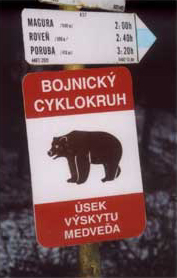
The bear is threatened in modern times not only by poaching but also by people moving further and further into his territory. The building of roads and recreation centres fragments and reduces the habitat for bears. Excessive collection of forest fruit causes an insufficiency of natural food, mainly in the autumn, when bears are laying down fat reserves for the winter. The large number of hikers, mushroom and fruit pickers is a constant disturbance to the bear.
The bear living in this country is a great rarity in Europe, when it has already disappeared from many states. For this majestic animal of our forests to survive in his natural environment for future generations, cooperation is needed among conservationists, National Park staff and hunters but also the public – all those who visit and love our mountains.
